2021 CHEVROLET COLORADO cruise control
[x] Cancel search: cruise controlPage 16 of 89

Chevrolet/GMC 2.8L Duramax Diesel Engine Supplement (GMNA-Localizing-
U.S./Canada-14465442) - 2021 - CRC - 2/3/20
Driving and Operating 15
{Warning
Do not use gasoline or starting aids, such
as ether, in the air intake. They could
damage the engine, which may not be
covered by the vehicle warranty. They
could also cause a fire, which could cause
serious personal injury.
Engine Idle Variations
Under certain conditions the engine idle
speed can vary or be elevated. Change in
idle speed is normal and does not indicate a
problem. Normal conditions that can raise
idle speed are low voltage, DPF
regeneration, air conditioning compressor
loads, and engine warmup. These speeds can
range from approximately 600 to 1000 rpm.
Elevated Idle
The engine has a cold temperature high idle
feature which elevates the engine idle speed
from base idle to 1050 to 1100 rpm for
pickup models or 1200 rpm for van models
when outside temperatures are below 0 °C
(32 °F), and the engine coolant temperature
is below 65 °C (150 °F). This feature enhances
heater performance by raising the engine
coolant temperature faster.To turn this feature on or off on pickup
models, see
Vehicle Personalization (Van
Models) 011 or
Vehicle Personalization (Pickup Models) 011.
On van models, this feature can be turned
on and off using the DIC buttons.
When the engine is started, it will slowly
ramp up to the high idle speed after a delay
of a few seconds up to approximately
two minutes. For this method to work
properly there must be no throttle or brake
pedal faults.
The engine idle speed will return to normal
once the following conditions are met:
.Engine coolant temperature reaches 65 °C
(150 °F).
.Air intake temperature reaches 0 °C
(32 °F).
The high idle speed will be temporarily
interrupted and the engine speed will return
to normal if any of the following conditions
occur:
.The brake pedal is applied.
.The accelerator pedal is pressed.
.The transmission is shifted out of P (Park)
or N (Neutral).
.Vehicle speed is detected. Once these inputs are removed, the engine
idle speed will slowly ramp back up to high
idle after the normal delay, if the conditions
for engine coolant temperature and air
intake temperature are still met.
Fast Idle Control (Vans Only)
The vehicle may have this system which can
be used to increase the engine idle speed.
Fast Idle control will be enabled when the
following conditions are met:
.The parking brake is set.
.The transmission is in P (Park) or
N (Neutral).
.The vehicle speed is about
0 km/h (0 mph).
.The cruise control Set switch is pressed
and released for Preset Fast Idle Speed
(1200 rpm).
Fast Idle control will be disabled when one
or more of the following conditions occur:
.The cruise control Set switch is pressed
and released. See “Cruise Control”in the
owner’s manual.
.The cruise control Cancel switch is
pressed.
.The brake pedal is pressed.
Page 25 of 89
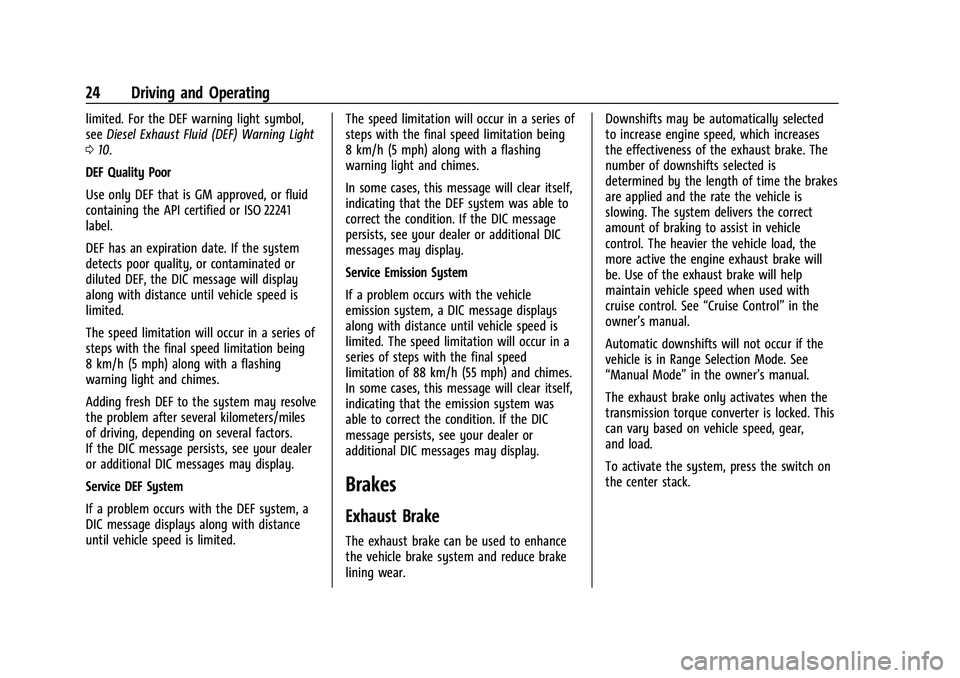
Chevrolet/GMC 2.8L Duramax Diesel Engine Supplement (GMNA-Localizing-
U.S./Canada-14465442) - 2021 - CRC - 2/3/20
24 Driving and Operating
limited. For the DEF warning light symbol,
seeDiesel Exhaust Fluid (DEF) Warning Light
0 10.
DEF Quality Poor
Use only DEF that is GM approved, or fluid
containing the API certified or ISO 22241
label.
DEF has an expiration date. If the system
detects poor quality, or contaminated or
diluted DEF, the DIC message will display
along with distance until vehicle speed is
limited.
The speed limitation will occur in a series of
steps with the final speed limitation being
8 km/h (5 mph) along with a flashing
warning light and chimes.
Adding fresh DEF to the system may resolve
the problem after several kilometers/miles
of driving, depending on several factors.
If the DIC message persists, see your dealer
or additional DIC messages may display.
Service DEF System
If a problem occurs with the DEF system, a
DIC message displays along with distance
until vehicle speed is limited. The speed limitation will occur in a series of
steps with the final speed limitation being
8 km/h (5 mph) along with a flashing
warning light and chimes.
In some cases, this message will clear itself,
indicating that the DEF system was able to
correct the condition. If the DIC message
persists, see your dealer or additional DIC
messages may display.
Service Emission System
If a problem occurs with the vehicle
emission system, a DIC message displays
along with distance until vehicle speed is
limited. The speed limitation will occur in a
series of steps with the final speed
limitation of 88 km/h (55 mph) and chimes.
In some cases, this message will clear itself,
indicating that the emission system was
able to correct the condition. If the DIC
message persists, see your dealer or
additional DIC messages may display.
Brakes
Exhaust Brake
The exhaust brake can be used to enhance
the vehicle brake system and reduce brake
lining wear.Downshifts may be automatically selected
to increase engine speed, which increases
the effectiveness of the exhaust brake. The
number of downshifts selected is
determined by the length of time the brakes
are applied and the rate the vehicle is
slowing. The system delivers the correct
amount of braking to assist in vehicle
control. The heavier the vehicle load, the
more active the engine exhaust brake will
be. Use of the exhaust brake will help
maintain vehicle speed when used with
cruise control. See
“Cruise Control”in the
owner’s manual.
Automatic downshifts will not occur if the
vehicle is in Range Selection Mode. See
“Manual Mode” in the owner’s manual.
The exhaust brake only activates when the
transmission torque converter is locked. This
can vary based on vehicle speed, gear,
and load.
To activate the system, press the switch on
the center stack.
Page 39 of 89
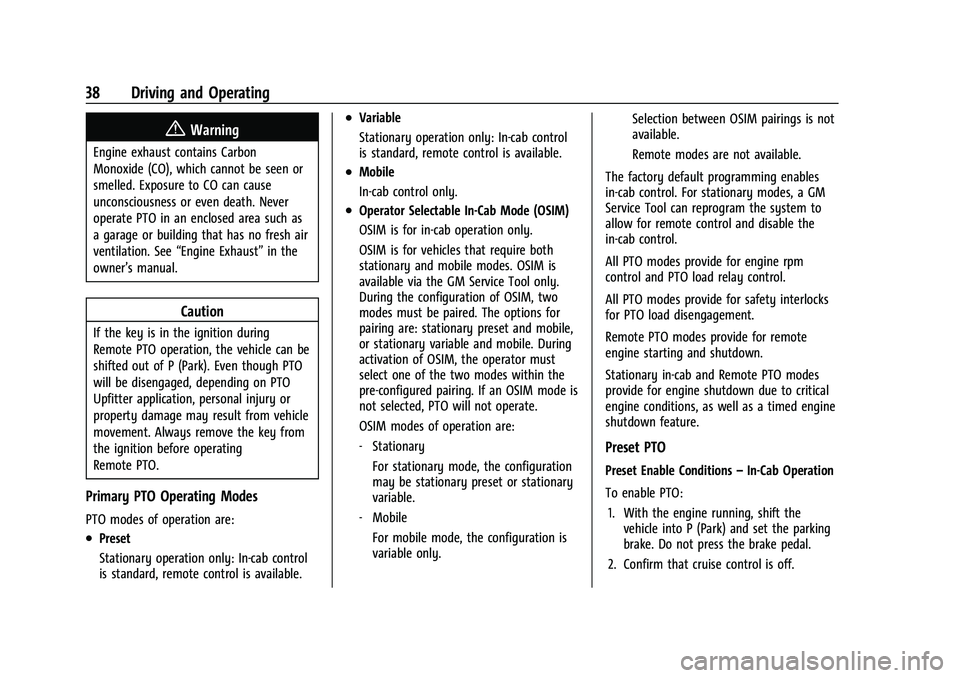
Chevrolet/GMC 2.8L Duramax Diesel Engine Supplement (GMNA-Localizing-
U.S./Canada-14465442) - 2021 - CRC - 2/3/20
38 Driving and Operating
{Warning
Engine exhaust contains Carbon
Monoxide (CO), which cannot be seen or
smelled. Exposure to CO can cause
unconsciousness or even death. Never
operate PTO in an enclosed area such as
a garage or building that has no fresh air
ventilation. See“Engine Exhaust” in the
owner’s manual.
Caution
If the key is in the ignition during
Remote PTO operation, the vehicle can be
shifted out of P (Park). Even though PTO
will be disengaged, depending on PTO
Upfitter application, personal injury or
property damage may result from vehicle
movement. Always remove the key from
the ignition before operating
Remote PTO.
Primary PTO Operating Modes
PTO modes of operation are:
.Preset
Stationary operation only: In-cab control
is standard, remote control is available.
.Variable
Stationary operation only: In-cab control
is standard, remote control is available.
.Mobile
In-cab control only.
.Operator Selectable In-Cab Mode (OSIM)
OSIM is for in-cab operation only.
OSIM is for vehicles that require both
stationary and mobile modes. OSIM is
available via the GM Service Tool only.
During the configuration of OSIM, two
modes must be paired. The options for
pairing are: stationary preset and mobile,
or stationary variable and mobile. During
activation of OSIM, the operator must
select one of the two modes within the
pre-configured pairing. If an OSIM mode is
not selected, PTO will not operate.
OSIM modes of operation are:
‐ Stationary
For stationary mode, the configuration
may be stationary preset or stationary
variable.
‐ Mobile
For mobile mode, the configuration is
variable only. Selection between OSIM pairings is not
available.
Remote modes are not available.
The factory default programming enables
in-cab control. For stationary modes, a GM
Service Tool can reprogram the system to
allow for remote control and disable the
in-cab control.
All PTO modes provide for engine rpm
control and PTO load relay control.
All PTO modes provide for safety interlocks
for PTO load disengagement.
Remote PTO modes provide for remote
engine starting and shutdown.
Stationary in-cab and Remote PTO modes
provide for engine shutdown due to critical
engine conditions, as well as a timed engine
shutdown feature.
Preset PTO
Preset Enable Conditions –In-Cab Operation
To enable PTO: 1. With the engine running, shift the vehicle into P (Park) and set the parking
brake. Do not press the brake pedal.
2. Confirm that cruise control is off.
Page 40 of 89
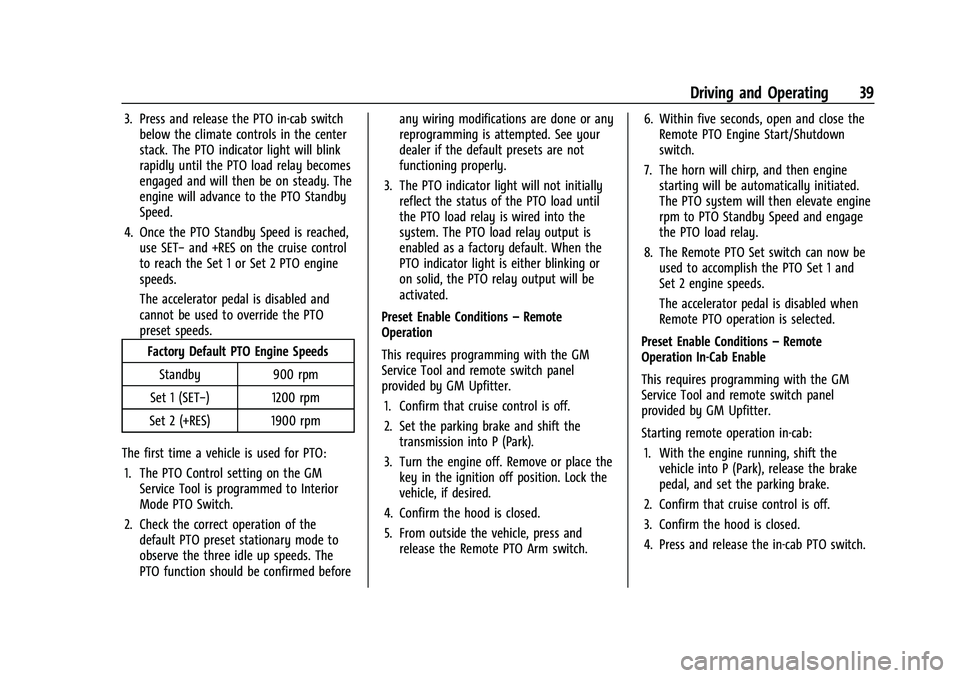
Chevrolet/GMC 2.8L Duramax Diesel Engine Supplement (GMNA-Localizing-
U.S./Canada-14465442) - 2021 - CRC - 2/3/20
Driving and Operating 39
3. Press and release the PTO in-cab switchbelow the climate controls in the center
stack. The PTO indicator light will blink
rapidly until the PTO load relay becomes
engaged and will then be on steady. The
engine will advance to the PTO Standby
Speed.
4. Once the PTO Standby Speed is reached, use SET− and +RES on the cruise control
to reach the Set 1 or Set 2 PTO engine
speeds.
The accelerator pedal is disabled and
cannot be used to override the PTO
preset speeds.
Factory Default PTO Engine Speeds
Standby 900 rpm
Set 1 (SET−) 1200 rpm
Set 2 (+RES) 1900 rpm
The first time a vehicle is used for PTO: 1. The PTO Control setting on the GM Service Tool is programmed to Interior
Mode PTO Switch.
2. Check the correct operation of the default PTO preset stationary mode to
observe the three idle up speeds. The
PTO function should be confirmed before any wiring modifications are done or any
reprogramming is attempted. See your
dealer if the default presets are not
functioning properly.
3. The PTO indicator light will not initially reflect the status of the PTO load until
the PTO load relay is wired into the
system. The PTO load relay output is
enabled as a factory default. When the
PTO indicator light is either blinking or
on solid, the PTO relay output will be
activated.
Preset Enable Conditions –Remote
Operation
This requires programming with the GM
Service Tool and remote switch panel
provided by GM Upfitter.
1. Confirm that cruise control is off.
2. Set the parking brake and shift the transmission into P (Park).
3. Turn the engine off. Remove or place the key in the ignition off position. Lock the
vehicle, if desired.
4. Confirm the hood is closed.
5. From outside the vehicle, press and release the Remote PTO Arm switch. 6. Within five seconds, open and close the
Remote PTO Engine Start/Shutdown
switch.
7. The horn will chirp, and then engine starting will be automatically initiated.
The PTO system will then elevate engine
rpm to PTO Standby Speed and engage
the PTO load relay.
8. The Remote PTO Set switch can now be used to accomplish the PTO Set 1 and
Set 2 engine speeds.
The accelerator pedal is disabled when
Remote PTO operation is selected.
Preset Enable Conditions –Remote
Operation In-Cab Enable
This requires programming with the GM
Service Tool and remote switch panel
provided by GM Upfitter.
Starting remote operation in-cab:
1. With the engine running, shift the vehicle into P (Park), release the brake
pedal, and set the parking brake.
2. Confirm that cruise control is off.
3. Confirm the hood is closed.
4. Press and release the in-cab PTO switch.
Page 41 of 89
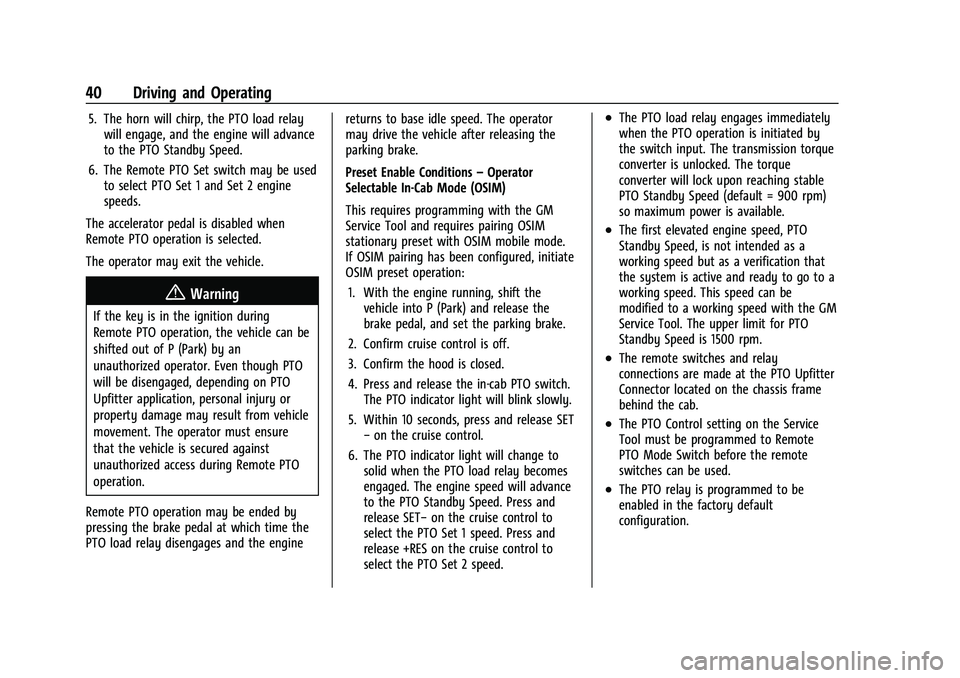
Chevrolet/GMC 2.8L Duramax Diesel Engine Supplement (GMNA-Localizing-
U.S./Canada-14465442) - 2021 - CRC - 2/3/20
40 Driving and Operating
5. The horn will chirp, the PTO load relaywill engage, and the engine will advance
to the PTO Standby Speed.
6. The Remote PTO Set switch may be used to select PTO Set 1 and Set 2 engine
speeds.
The accelerator pedal is disabled when
Remote PTO operation is selected.
The operator may exit the vehicle.
{Warning
If the key is in the ignition during
Remote PTO operation, the vehicle can be
shifted out of P (Park) by an
unauthorized operator. Even though PTO
will be disengaged, depending on PTO
Upfitter application, personal injury or
property damage may result from vehicle
movement. The operator must ensure
that the vehicle is secured against
unauthorized access during Remote PTO
operation.
Remote PTO operation may be ended by
pressing the brake pedal at which time the
PTO load relay disengages and the engine returns to base idle speed. The operator
may drive the vehicle after releasing the
parking brake.
Preset Enable Conditions
–Operator
Selectable In-Cab Mode (OSIM)
This requires programming with the GM
Service Tool and requires pairing OSIM
stationary preset with OSIM mobile mode.
If OSIM pairing has been configured, initiate
OSIM preset operation:
1. With the engine running, shift the vehicle into P (Park) and release the
brake pedal, and set the parking brake.
2. Confirm cruise control is off.
3. Confirm the hood is closed.
4. Press and release the in-cab PTO switch. The PTO indicator light will blink slowly.
5. Within 10 seconds, press and release SET −on the cruise control.
6. The PTO indicator light will change to solid when the PTO load relay becomes
engaged. The engine speed will advance
to the PTO Standby Speed. Press and
release SET− on the cruise control to
select the PTO Set 1 speed. Press and
release +RES on the cruise control to
select the PTO Set 2 speed.
.The PTO load relay engages immediately
when the PTO operation is initiated by
the switch input. The transmission torque
converter is unlocked. The torque
converter will lock upon reaching stable
PTO Standby Speed (default = 900 rpm)
so maximum power is available.
.The first elevated engine speed, PTO
Standby Speed, is not intended as a
working speed but as a verification that
the system is active and ready to go to a
working speed. This speed can be
modified to a working speed with the GM
Service Tool. The upper limit for PTO
Standby Speed is 1500 rpm.
.The remote switches and relay
connections are made at the PTO Upfitter
Connector located on the chassis frame
behind the cab.
.The PTO Control setting on the Service
Tool must be programmed to Remote
PTO Mode Switch before the remote
switches can be used.
.The PTO relay is programmed to be
enabled in the factory default
configuration.
Page 42 of 89
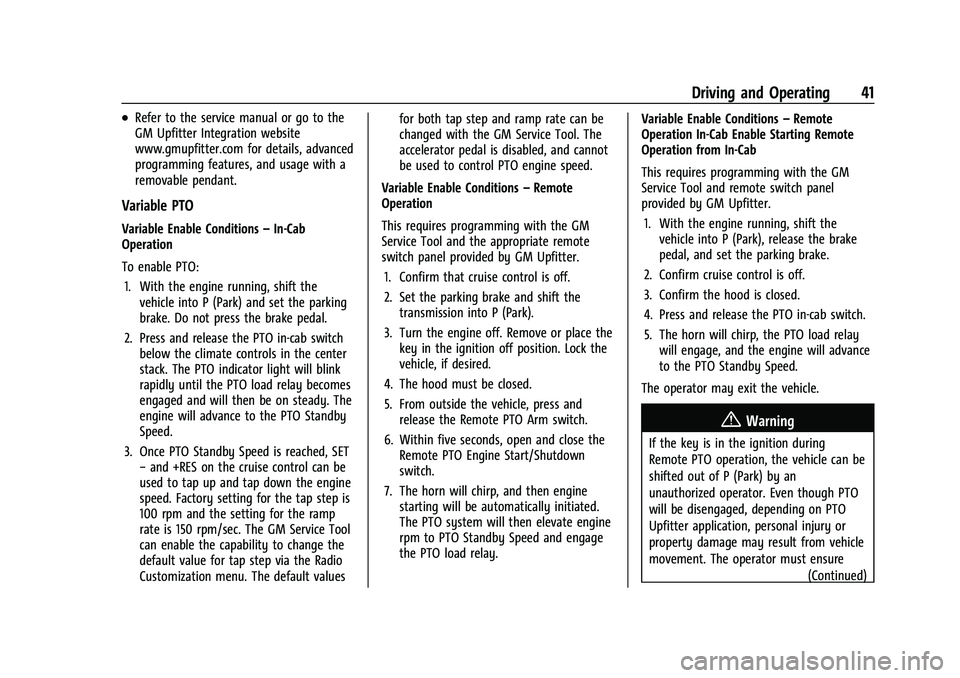
Chevrolet/GMC 2.8L Duramax Diesel Engine Supplement (GMNA-Localizing-
U.S./Canada-14465442) - 2021 - CRC - 2/3/20
Driving and Operating 41
.Refer to the service manual or go to the
GM Upfitter Integration website
www.gmupfitter.com for details, advanced
programming features, and usage with a
removable pendant.
Variable PTO
Variable Enable Conditions–In-Cab
Operation
To enable PTO:
1. With the engine running, shift the vehicle into P (Park) and set the parking
brake. Do not press the brake pedal.
2. Press and release the PTO in-cab switch below the climate controls in the center
stack. The PTO indicator light will blink
rapidly until the PTO load relay becomes
engaged and will then be on steady. The
engine will advance to the PTO Standby
Speed.
3. Once PTO Standby Speed is reached, SET −and +RES on the cruise control can be
used to tap up and tap down the engine
speed. Factory setting for the tap step is
100 rpm and the setting for the ramp
rate is 150 rpm/sec. The GM Service Tool
can enable the capability to change the
default value for tap step via the Radio
Customization menu. The default values for both tap step and ramp rate can be
changed with the GM Service Tool. The
accelerator pedal is disabled, and cannot
be used to control PTO engine speed.
Variable Enable Conditions –Remote
Operation
This requires programming with the GM
Service Tool and the appropriate remote
switch panel provided by GM Upfitter.
1. Confirm that cruise control is off.
2. Set the parking brake and shift the transmission into P (Park).
3. Turn the engine off. Remove or place the key in the ignition off position. Lock the
vehicle, if desired.
4. The hood must be closed.
5. From outside the vehicle, press and release the Remote PTO Arm switch.
6. Within five seconds, open and close the Remote PTO Engine Start/Shutdown
switch.
7. The horn will chirp, and then engine starting will be automatically initiated.
The PTO system will then elevate engine
rpm to PTO Standby Speed and engage
the PTO load relay. Variable Enable Conditions
–Remote
Operation In-Cab Enable Starting Remote
Operation from In-Cab
This requires programming with the GM
Service Tool and remote switch panel
provided by GM Upfitter.
1. With the engine running, shift the vehicle into P (Park), release the brake
pedal, and set the parking brake.
2. Confirm cruise control is off.
3. Confirm the hood is closed.
4. Press and release the PTO in-cab switch.
5. The horn will chirp, the PTO load relay will engage, and the engine will advance
to the PTO Standby Speed.
The operator may exit the vehicle.
{Warning
If the key is in the ignition during
Remote PTO operation, the vehicle can be
shifted out of P (Park) by an
unauthorized operator. Even though PTO
will be disengaged, depending on PTO
Upfitter application, personal injury or
property damage may result from vehicle
movement. The operator must ensure (Continued)
Page 43 of 89

Chevrolet/GMC 2.8L Duramax Diesel Engine Supplement (GMNA-Localizing-
U.S./Canada-14465442) - 2021 - CRC - 2/3/20
42 Driving and Operating
Warning (Continued)
that the vehicle is secured against
unauthorized access during Remote PTO
operation.
The accelerator pedal is disabled when
Remote PTO operation is selected.
Remote PTO operation can be ended by
pressing the brake pedal. The PTO load relay
disengages and the engine returns to base
idle speed. The operator may drive the
vehicle after releasing the parking brake.
.The desired engine operating speed can
now be accomplished. Two versions of
engine rpm control are available, switches
or potentiometer, depending on which
one was installed.
‐ Switches –the Remote PTO Set and
Resume switches can be used to tap up
and tap down to the desired engine
speed.
‐ Potentiometer –a Remote PTO Throttle
Potentiometer can be used as a
continuous variable throttle control to
dial in the desired engine speed. Variable Enable Conditions
–OSIM
This requires programming with the GM
Service Tool and specific pairing of
stationary variable and mobile modes.
Remote operation is not available.
If OSIM pairing has been configured, initiate
OSIM stationary variable operation: 1. With the engine running, shift the vehicle into P (Park), release the brake
pedal, and set the parking brake.
2. Confirm cruise control is off.
3. Confirm the hood is closed.
4. Press and release the PTO in-cab switch. The PTO indicator light will blink slowly.
5. Within 10 seconds, press and release SET− on the cruise control. The PTO load
relay will engage and the PTO indicator
light will change to solid. The engine
speed will advance to the PTO Standby
Speed.
6. The desired operating speed may be achieved by tapping up and down with
+RES and SET− on the cruise control.
.The PTO load relay engages immediately
when the PTO operation is initiated by
the switch input. The transmission torque
converter is unlocked. The torque converter will lock upon reaching stable
PTO Standby Speed (default = 900 rpm)
so maximum power is available.
.The first elevated engine speed, PTO
Standby Speed, is not intended as a
working speed but as a verification that
the system is active and ready to go to a
working speed.
.The relay connections are made at the
PTO Upfitter Connector located on the
chassis frame behind the cab.
.The engine speeds can be adjusted
between the low of PTO Standby Speed
and the high of PTO Max Engine speed
limits. Both values can be modified from
the factory default settings with the GM
Service Tool. Based on the value chosen
for PTO Max Engine Speed, the PTO menu
in the center stack may show speeds that
are not available.
.Factory setting for the tap step is 100
rpm and the setting for ramp rate is 150
rpm/sec. The default value for tap step
can be modified via the Radio
Customization menu. The default values
for both tap step and ramp rate can be
changed with the GM Service Tool.
.The PTO load relay is enabled as the
factory default programmed setting.
Page 44 of 89
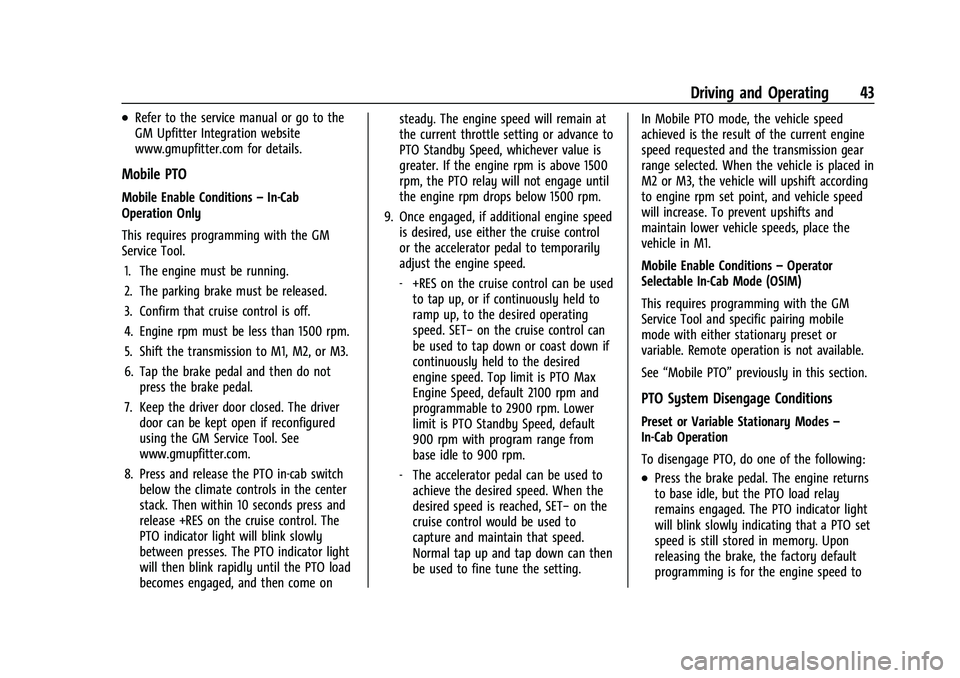
Chevrolet/GMC 2.8L Duramax Diesel Engine Supplement (GMNA-Localizing-
U.S./Canada-14465442) - 2021 - CRC - 2/3/20
Driving and Operating 43
.Refer to the service manual or go to the
GM Upfitter Integration website
www.gmupfitter.com for details.
Mobile PTO
Mobile Enable Conditions–In-Cab
Operation Only
This requires programming with the GM
Service Tool.
1. The engine must be running.
2. The parking brake must be released.
3. Confirm that cruise control is off.
4. Engine rpm must be less than 1500 rpm.
5. Shift the transmission to M1, M2, or M3.
6. Tap the brake pedal and then do not press the brake pedal.
7. Keep the driver door closed. The driver door can be kept open if reconfigured
using the GM Service Tool. See
www.gmupfitter.com.
8. Press and release the PTO in-cab switch below the climate controls in the center
stack. Then within 10 seconds press and
release +RES on the cruise control. The
PTO indicator light will blink slowly
between presses. The PTO indicator light
will then blink rapidly until the PTO load
becomes engaged, and then come on steady. The engine speed will remain at
the current throttle setting or advance to
PTO Standby Speed, whichever value is
greater. If the engine rpm is above 1500
rpm, the PTO relay will not engage until
the engine rpm drops below 1500 rpm.
9. Once engaged, if additional engine speed is desired, use either the cruise control
or the accelerator pedal to temporarily
adjust the engine speed.
‐+RES on the cruise control can be used
to tap up, or if continuously held to
ramp up, to the desired operating
speed. SET− on the cruise control can
be used to tap down or coast down if
continuously held to the desired
engine speed. Top limit is PTO Max
Engine Speed, default 2100 rpm and
programmable to 2900 rpm. Lower
limit is PTO Standby Speed, default
900 rpm with program range from
base idle to 900 rpm.
‐ The accelerator pedal can be used to
achieve the desired speed. When the
desired speed is reached, SET− on the
cruise control would be used to
capture and maintain that speed.
Normal tap up and tap down can then
be used to fine tune the setting. In Mobile PTO mode, the vehicle speed
achieved is the result of the current engine
speed requested and the transmission gear
range selected. When the vehicle is placed in
M2 or M3, the vehicle will upshift according
to engine rpm set point, and vehicle speed
will increase. To prevent upshifts and
maintain lower vehicle speeds, place the
vehicle in M1.
Mobile Enable Conditions
–Operator
Selectable In-Cab Mode (OSIM)
This requires programming with the GM
Service Tool and specific pairing mobile
mode with either stationary preset or
variable. Remote operation is not available.
See “Mobile PTO” previously in this section.
PTO System Disengage Conditions
Preset or Variable Stationary Modes –
In-Cab Operation
To disengage PTO, do one of the following:
.Press the brake pedal. The engine returns
to base idle, but the PTO load relay
remains engaged. The PTO indicator light
will blink slowly indicating that a PTO set
speed is still stored in memory. Upon
releasing the brake, the factory default
programming is for the engine speed to